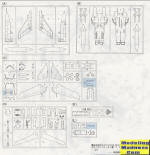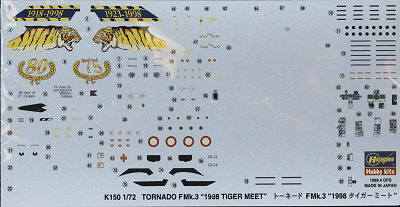
| KIT #: | 04450 |
| PRICE: | 1800 yen SRP |
| DECALS: | One option |
| REVIEWER: | Scott Van Aken |
| NOTES: | 1999 Limited Edition |

| HISTORY |
The Panavia Tornado Air Defence Variant (ADV) was a long-range, twin-engine interceptor version of the swing-wing Panavia Tornado. The aircraft's first flight was on 27 October 1979, and it entered service with the Royal Air Force (RAF) in 1986. It was also previously operated by the Italian Air Force (AMI) and the Royal Saudi Air Force (RSAF).
The Tornado ADV was originally designed to intercept Soviet bombers as they were traversing across the North Sea with the aim of preventing a successful air-launched nuclear attack against the United Kingdom. In this capacity, it was equipped with a powerful radar and beyond-visual-range missiles, however initial aircraft produced to the F2 standard lacked radars due to development issues. The follow-up F3 standard was the definitive variant used by the RAF, as well as all Tornado ADV aircraft that were leased by the AMI and procured by the RSAF.
During its service life, the Tornado ADV received several upgrade programmes which enhanced its aerial capabilities and enabled it to perform the Suppression of Enemy Air Defenses (SEAD) mission in addition to its interceptor duties. Ultimately, both the RAF and RSAF retired their Tornado ADV fleets; the type has been replaced in both services by the newer, multi-role Eurofighter Typhoon. The last aircraft was retired in 2011. Interestingly, the aircraft itself was not significantly superior to the Phantom that it replaced, but had much more advanced weapons systems.
| THE KIT |
 Not
surprisingly, the Tornado F.3 has many of the same sprues as the standard
GR.1/IDS strike fighter, differing mostly in the nose section, which carries the
more powerful radar. Since the cockpit tub is the same, one has to do some
carving to allow the lower fuselage piece, which has indentations for the
Skyflash missiles, to properly fit. You are provided a guide. You have the
options of raised detail and/or decals for the instrument panels and side
consoles. Each three piece bang seat has some belt detail. With that done the
nose can be joined.
Not
surprisingly, the Tornado F.3 has many of the same sprues as the standard
GR.1/IDS strike fighter, differing mostly in the nose section, which carries the
more powerful radar. Since the cockpit tub is the same, one has to do some
carving to allow the lower fuselage piece, which has indentations for the
Skyflash missiles, to properly fit. You are provided a guide. You have the
options of raised detail and/or decals for the instrument panels and side
consoles. Each three piece bang seat has some belt detail. With that done the
nose can be joined.
The lower fuselage has inserts for both the gear wells and for a short distance of the engine intakes. Swing wings are geared together so you can move them if you so wish These are trapped between the upper and lower fuselage sections. After installing the upper and inner intake pieces along with the appropriate decals, you can attach the nose and then the outer intake bits.
Construction then moves to the landing gear, gear
doors and the tailplanes. The horizontal stabs are not joined and are attached
with a small pin into the rear fuselage. The exhaust section is then attached.
While the speed brakes are able to be posed open, they were rarely posed this
way on the ground. A two piece windscreen/canopy is provided and is supposed to
be posed closed. For things under wings you have a pair of pylons on which a
pair of Sidewinders and the
 larger 'Hindenberg'
tanks are attached. Four Skyflash are provided for the lower fuselage.
larger 'Hindenberg'
tanks are attached. Four Skyflash are provided for the lower fuselage.
Markings are provided for one aircraft from 53 Stormo/21 Gruppo, Italian Air Force in very nice Tiger Meet markings from 1998. It is in the standard two tone grey scheme of Barley Grey over Light Aircraft Grey. The decal sheet is very nicely done and provides all the markings needed including those for the weapons and for the fuel tanks.
| CONCLUSIONS |
It looks like a very nice kit in the box. Now apparently Hasegawa Tornado kits have some sort of shape issue around the cockpit area, but really, unless this is placed next to one that is 'correct' (which I assume is the Revell kit), then really I doubt anyone who isn't very well versed on the type will notice. Other boxings of this kit are fairly easy to find and at reasonable prices.
| REFERENCES |
https://en.wikipedia.org/wiki/Panavia_Tornado_ADV
January 2020
Copyright ModelingMadness.com. All rights reserved.
If you would like your product reviewed fairly and fairly quickly, please contact the editor or see other details in the Note to Contributors.
Back to the Main Page Back to the Review Index Page Back to the Previews Index Page